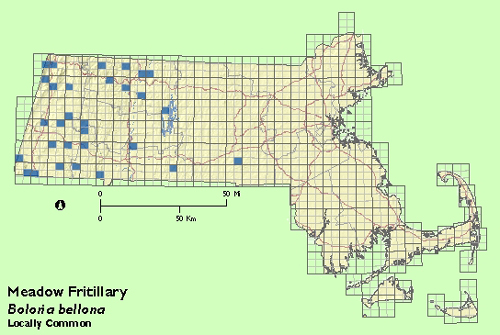Find a Butterfly
Meadow Fritillary
Boloria bellona
Named
Fabricus, 1775

Identification
Wingspan: 1 1/4 - 1 7/8". The Meadow Fritillary is one of two species of small fritillaries that occur in Massachusetts. This species may be told from the Silver bordered Fritillary (B. selene), which overlaps it in flight dates and occurs in similar habitats, by wing shape and coloration. In the Meadow Fritillary the forewing tip is slanted outward and is somewhat blunt. The hindwing below lacks the silvery spots of the Silver bordered Fritillary, instead being mottled with browns and grays and often displaying a purplish sheen. Variegated Fritillary has a similar hindwing pattern below but has a pointed forewing and is considerably larger. Two other orange and black species that may share the Meadow Fritillary‘s habitat are Pearl Crescent (Phyciodes tharos) and Harris‘ Checkerspot (Chlosyne harrisii). The Pearl Crescent is usually noticeably smaller and has more black on the wings above showing distinct black borders absent in Meadow Fritillary. Harris‘ Checkerspot is much darker above and boldly patterned below.
Distribution
British Columbia east across central and southern Canada to Quebec and the Maritimes, south to Washington, Missouri, and North Carolina. Throughout New England.
Status in Massachusetts
Scudder (1889) reported the Meadow Fritillary as common around Boston and other eastern Massachusetts sites, noting that it was less common in mid-summer and most common during last flight. Farquhar called it "common and general". As recently as the late 1950s scattered colonies were still present in eastern Massachusetts (pers. comm. W. Petersen), and Mello (pers comm. Says that it was still common in the New Bedford area in wet meadows in early ‘60‘s). Now uncommon and local however occurring largely from the Connecticut River valley westward to over 1300 feet in the Berkshire hills. During the Atlas period, all records were from the western half of the state except for a single occurrence in southern Worcester County. Maxima: 9, 15 July 1878, Belchertown (Hampshire Co.).

Flight Period in Massachusetts
Three flights: early May to late June, early to late July, and early August to September. Extreme dates: 7 May 1938, Amherst (Hampshire Co.), Irwin; 24 September 1995, Hadley (Hampshire Co.), J. Center.
Larval Food Plants
Violets (Viola spp.).
Adult Food sources
During the Atlas, recorded at dogbane, Swamp Milkweed, and Black-eyed Susans in Massachusetts.

Habitat
Open areas such as pastures, hay fields, old beaver meadows or roadside mowings.
Life Cycle
EGG: Pale yellow; pear shaped with numerous ribs. OVIPOSITION: eggs laid on a variety of non host plants — "rarely on violets" (Scott 1986). LARVA: Dark with purplish lateral stripe and branched spines. CHRYSALIS: yellowish brown. OVERWINTERING STAGE: Late instar larva.
Adults of the first brood begin emerging in early May, with fresh individuals appearing into the month of June. Meadow Fritillaries spend most of the day patrolling open meadows in a low, rapid, jerky flight which is difficult to follow for any distance. The second brood emerges in early July, and egg laying takes place almost immediately (Scudder, 1889). Some of the resulting larvae pupate and produce August‘s and September‘s third brood, while others overwinter as larvae.
Account Author
Mark Fairbrother



